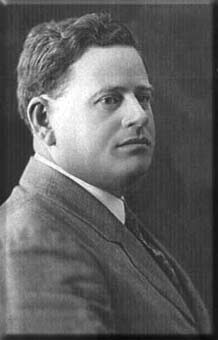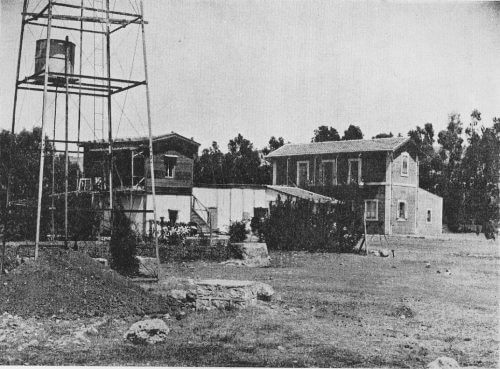Aharon Aharenson, who died a hundred years ago this week (May 15), is known to many as the discoverer of the mother of wheat and one of the founders of the Nili underground. But few know that he also dealt with issues that are troubling ecologists and environmentalists today - from saving endangered species to preventing fires and stopping locust swarms
Michael Belcher, Angle - news agency for science and the environment
One hundred years have passed since the tragic and mysterious death of Aaron Aaronson on May 15, 1919 in a small plane that disappeared over the English Channel on the way from London to France. Articles and books have been written about the great man and his activities as a research agronomist and a Zionist statesman, mainly about the discovery of the wild wheat populations in the north of the country, about the founding of an experimental agricultural station in Atlit and the establishment of the Nili underground. On the other hand, less has been revealed to the public about his deep knowledge of the land, his talents as a wide-eyed and single-eyed nature surveyor, and the beginning of his work in the Land of Israel in areas that are accepted today as belonging to practical ecology and even nature conservation.
An opinion on Ahernson's legacy is presented here in the context of the era in which his turbulent life was cut short, but from a contemporary point of view of applied ecology.

The treasure from the experiment station
The term "biodiversity", which is common today in the field of nature conservation and refers to the variety of animals and plants that exist in a certain area, was not used in Aharenson's time, but he was the first in the Jewish settlement in Israel to work practically and systematically in this field on its many aspects, which begin with scientific documentation. In 1914, his herbarium contained more than 20,000 plant specimens collected in Israel, including very rare species that had not been recorded in Israel before. This treasure survived thanks to the Ahernson family who managed to save it during the destruction of the "Jewish agricultural experiment station" in Atlit by the Ottoman government after it was uncovered from the Nili underground. Since 1980, Aaronson's herbarium has been preserved in the national collections of the State of Israel, as a separate wing of special scientific and historical value.
Ahernson was not only involved in documenting the botanical diversity, he was also no stranger to zoology. For example, the Atlit station had a very rich collection of freshwater molluscs and a collection of insects useful in agriculture. The most accessible means of collecting information today - photography, was at the beginning of the 20th century still in its infancy, but Ahernson acquired the profession and used it to document thousands of photographs of landscape sites, special trees, details of plants, traditional agriculture, and the like.
Even terms such as "the gene bank" or "ex-situ conservation" (preservation of an endangered species outside its natural habitat) were not yet in the language of applied science about a century ago, but Ahernson was then looking for local varieties of vine, olive, carob, fig and plants Cultivated others, as well as rare species of wild trees from the Land of Israel, and tried to preserve them in the living collections at the experiment station. At the beginning of the last century, he emphasized the danger of the loss of the local varieties following the general unification that would accompany the course of national development in the country. The first Red Book of Threatened Species in Elam was published more than four decades after Ahernson's death, but the term "endangered species" appears in the title of his article as early as 1913, in the era of the dawn of nature conservation in Europe and North America, at a time when no one else was writing on the subject and probably also He did not think about it in the context of the Land of Israel, including the foreign explorers who visited it.
It is worth noting that along with the matter of preventing the extinction of rare species and varieties, Ahernson also acted as an expert at the other end of applied ecology - in dealing with the outbreak of species harmful to the economy and the health of the residents, including an extreme case of locust swarms, which continues to engage ecologists in Israel every few years to this day.

One of Aaron Aaronson's most important essays is a report on the subject of forests submitted on October 23, 1913 to the Ottoman authorities. The professional document was written in the spirit of love for nature, but also indicates the author's familiarity with the customs of the local population. Ahernson demanded that the law limit the use of wood for making charcoal and lime and ban the export of charcoal (which was mainly exported to Egypt). To encourage planting, he proposed to exempt from tax any landowner who fences off forest areas for the purpose of preserving them or who plants trees on vacant land.
Ahernson also warned against the exclusive use of conifers in afforestation due to the danger of fires, and recommended surrounding each plot with a strip of trees that are more resistant to flammability. He insisted on the need to establish a mechanism of "forest guards" and to encourage the organization of public associations of forest friends. These are just some of his proposals to stop the destruction of the forests in Israel and to restore them. As an anniversary years after the submission of the document in question, it was noted with great appreciation that the reader of Ahernson's memorandum "cannot help but marvel at the author's mastery of the forestry profession".
The study of biological invasions also began about 40 years after Ahrenson passed away, and the concept of "invasive species" made headlines in applied ecology only in recent decades. In this field, Ahernson was not ahead of his time in Israel. As an agronomist, he was also involved in the import of foreign idle trees, as many respectable gardeners and foresters around the world did. Even today there are those who continue this dubious action, but in many countries a strict risk assessment is already required.
Ahernson was probably the first to point out with an ecologist's keen eye the parallel environmental conditions of the Land of Israel and California, but his amazing intuition did not turn on a red light when he enthusiastically planted the Washington palm in the land. Today, the Washingtonia from the desert in California is a weed in the area of the historical experiment station in Atlit and other sites in Israel, and even an invasive plant in nature reserves. The writer of these lines, who carries in his heart a deep appreciation for Aaronson and his enterprises, allows himself to assume that if the giant man had had the opportunity to correct his error, he would have done so.
Aaron Aaronson's brilliant life was cut short. He was 43 years old when he died, his professional and political path was still ahead of him.
Michael Belcher is an ecologist at the Ein Gedi Reserve and the Dead Sea region, Nature and Parks Authority
Based on an opinion piece that will be published in the upcoming issue (June 2019) of "Ecology and Environment - a journal for environmental science and policy"
More of the topic in Hayadan:

One response
Yes, don't forget that he exterminated the bears from the land by hunting the last bear